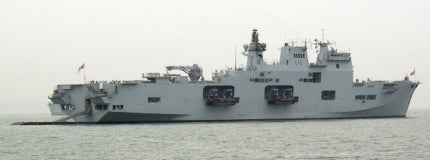
Two terrorist attacks have blighted past Olympic Games, but any number of planned attacks may have been prevented by the vigilance of security services, the police and the military.
Ultimate responsibility for coordinating all the security efforts for London’s turn, which will involve 10,000 police officers and 13,500 members of the armed forces at a cost of around £1bn, lies with the Home Office.
The threat to London is likely to come from land, sea and air and, as a result, London’s Olympic security strategy has proven to be a mammoth undertaking for an armed forces already feeling the pressure, following the latest tranche of defence cuts.
With the world’s eye cast on London for the sporting spectacle, how will the city prepare for all contingencies?
Defending the Olympic Park from terror attacks
At the 1996 Summer Olympics in Atlanta in Georgia, US, Eric Robert Rudolph planted three pipe bombs surrounded by nails near a stage in the Centennial Olympic Park while a concert was in progress. When the 40-pound explosive blew up, two people died and 111 were injured.
The London Olympic Park faces similar security issues, with the public being allowed on to the two square kilometre site to wander freely and attend un-ticketed events. However, access for the 200,000 people expected to visit the venue daily is not entirely open.
The park is sealed off with 16-foot high fencing topped off with a four-foot electric fence, all overseen by CCTV cameras which send continual footage to command-and-control centres. Admission takes place through four security-controlled access points, nicknamed ‘Tunnels of Truth’.
Delivered by Smiths Detection, the tunnels enable airport-like counter-terror checks that use a combination of high-tech sensors with regular clothes and bag searches to detect weapons, explosives and biohazards.
Security lessons learned from West Germany’s Munich Olympic Games
The Munich massacre, in which eleven Israeli athletes and coaches and a West German police officer were killed by members of the Palestinian terrorist organisation Black September, sparked a comprehensive inquest into how it was allowed to happen.
Prior to the Games, Olympic organisers tasked forensic psychologist Georg Sieber with compiling a list of 26 potential terrorist scenarios which could occur during the event in order to boost security. One particular scenario cited an attack of Palestinian origin against Israeli athletes involving the kidnap of hostages, leveraged against the release of Palestinian prisoners. This, along with other scenarios, was ignored in order to preserve the carefree and open image of the Games.
Further mistakes were made in the botched plan to rescue the athletes, due to ill-prepared and ill-equipped security forces and West Germany’s post-war constitution prohibiting military activity within the country. The resulting criticism of West Germany’s poor preparation for such an event caused many European nations to create elite and permanently available counter-terrorism forces, such as France’s GIGN and Germany’s GSG9, as well as the reorganisation of other units, such as the UK’s SAS.
With the SAS deeply involved in the London Olympics security operation and included in various training exercises which have occurred in the lead-up to the Games, it is highly unlikely that similar gaps in organisation are to occur this summer.
Security within the Olympic Village in London will also, understandably, be substantially more concrete than the chain-linked fences present in Munich in 1972. Security advisors will work with individual teams in partnership with official London 2012 security and, while no independent security operations are permitted, athletes will be assured of secure transportation between the village and event venues.
Keeping public transport safe during the 2012 Olympics
Less than 24 hours after the announcement that London had won its bid to host the 2012 summer Olympic games, a series of coordinated terrorist bomb attacks on London’s public transport system left 52 people dead and more than 700 injured. From that point forward, protecting London from terrorist attacks on its public transport network took the very highest priority.
Additional levels of security are being implemented during the Games, when 450,000 tourists will be staying in the capital. All visitors to the Olympics are being encouraged to travel by public transport, with many of the roads around the venues due to be closed to traffic other than approved delivery companies.
Safety measures are driven by the Transport Security Steering Group, which oversees the delivery of the transport security project within the Home Office-led Olympic and Paralympic safety and security programme.
For the duration of the Games, additional CCTV cameras will be brought in to deliver improved coverage and quality. Key transport hubs will be manned with police officers, and additional measures, such as weapons loops, may be introduced.
Protecting London’s Olympic air space from the ground and in the sky
Since the 9/11 attacks on the US using hijacked passenger aircraft, preventing a similar attack on London, especially during the Olympics, has been top of the agenda for the UK Armed Forces.
The multilayered Air Security Plan for the Olympics enhances existing arrangements which ensure UK airspace is protected. Ground-based radar systems and surveillance aircraft based throughout the UK provide a real-time picture of UK airspace. In the event of an alert, Typhoon aircraft and helicopters carrying snipers can be scrambled to intercept any potential threat. In February 2012, an exercise codenamed Taurus Mountain 2 tested this planned response.
The defence arrangements include the E3D Sentry AWACS (airborne early warning and control system) aircraft, but at the time of writing they have been temporarily grounded after cracks were found on the radar dome of one aircraft.
In November 2011 it was announced that surface-to-air missiles would be deployed in the UK for the first time since World War II, in a bid to boost defences at the 2012 London Olympic Games. However in March 2012 a Member of Parliament hit out at Ministry of Defence’s plans to install a missile base in his constituency of Shooter’s Hill, arguing that the site had been selected without consultation.
Securing the Thames with the Royal Navy’s HMS Ocean

HMS Ocean, the Royal Navy’s largest remaining carrier, will be stationed in the River Thames to provide logistics support. Image courtesy of Sharkbait784.
The River Thames is not only a unique and iconic feature of London, but also links the Olympic Village at Stratford with the venues located in North Greenwich through Bow Creek and Prescott Channel. As a result, security on the river has become a key focal point of London’s Olympic strategy.
As a result, security on the river has become a key focal point of London’s Olympic strategy. Chris Allison, a Metropolitan Police assistant commissioner, said: "The Thames runs through the heart of London and will be a popular place for people who want to be a part of the Olympic spirit. There is no specific threat from the river, but we would be failing in our duty to ignore it at games time."
"All of our planning is designed to mitigate against potential risks during the summer of 2012 and this is an example of where we will be using specialist military capability to support us," added Allison.
As a result, security has been closely analysed and exercises carried out in January 2012 in front of assembled media demonstrated that the Thames has not been overlooked. Elite military and police teams conducted Operation Woolwich Arsenal Pier, using offshore landing craft, rigid inflatable boats and a Lynx helicopter in order to conduct various drills, including the hijack of a Thames clipper.
Although the exercise demonstrated London’s resolve, perhaps a stronger sign of the city’s assembled military strength in preparation for the Olympics will be the arrival of HMS Ocean, the Royal Navy’s largest vessel, which is to be moored in Greenwich.
Although London has remained committed to a ‘blue’ Olympics, with as little visible military presence as possible, HMS Ocean, with a displacement capacity of 21,500 tons, has been tasked with providing logistics support, accommodation and a landing site for the helicopters tasked with providing aerial support for the duration of the Games.
Scanning London for the Olympic Games
Use of biometric scanners in order to secure the London Olympic Games started long before the opening ceremony. In order to access the Olympic Stadium construction site at Stratford, workers were required to go through a biometric scanner that took hand and iris readings, eliminating the need for passes or keys which could be stolen or copied.
They hold a striking resemblance to the techniques that will be used to combat the possible spread of disease during the Games, which will comprise of a disease-scanning system and computer software which analyses incidences of disease outbreak with live air-travel patterns, formulating the potential risk factor for any particular disease to spread to London.
To compliment the already famed CCTV infrastructure within London, new number plate and facial recognition software has been implemented to keep watch for any particular suspects or vehicles, all due to be monitored from within new police control centres. In essence, London is set to become the most watched Olympic Games in modern history, but not just in the traditional sense of sporting spectators.



